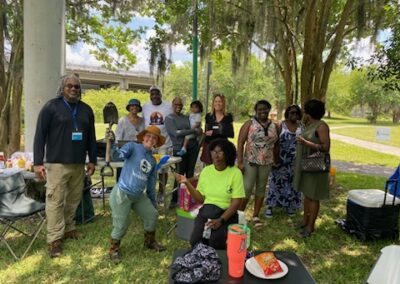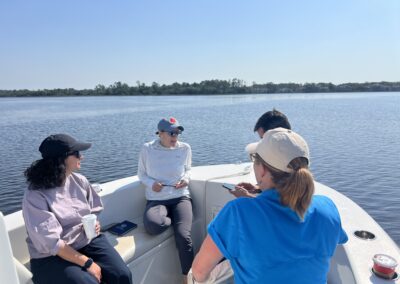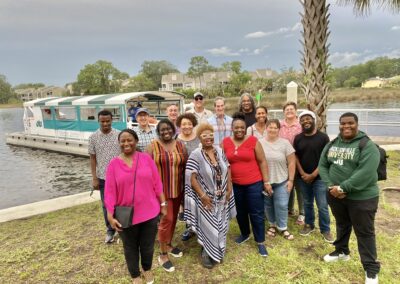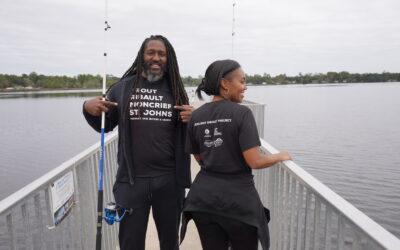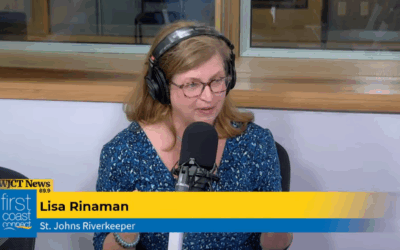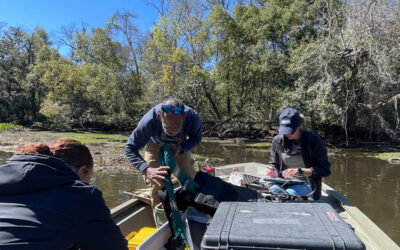Resilient Ribault
In 2023, St. Johns RIVERKEEPER and LISC Jacksonville launched Resilient Ribault, an initiative to address the challenges facing the waterways and communities in the Ribault River and Moncrief Creek watersheds. Both are tributaries of the St. Johns River.
This area of the St. Johns River watershed is highly vulnerable to flooding and pollution problems, in addition to numerous socioeconomic factors.
We collaborate with residents and community partners to:
- Provide equitable access to the river
- Assess and improve water quality
- Address flooding problems
- Ensure housing security
- Preserve and celebrate cultural heritage
- Advocate for infrastructure improvements
While healthy waterways are critical to our quality of life, this is not the only factor that impacts the overall health and wellbeing of our communities. By working with LISC, community members, and other partners, we are using our collective resources, knowledge and expertise to address problems more holistically to create more resilient neighborhoods.
Resilient Ribault is supported by a generous 5-year grant from the Delores Barr Weaver Legacy Fund. This will allow us to concentrate resources into a smaller geographic area for a prolonged time period, involving the entire St. Johns Riverkeeper team in an effort to maximize our impact and build the trust and relationships necessary to be successful. By working with LISC and other community partners, we will also be able to take a more holistic approach to creating more resilient neighborhoods. We hope to create an approach and model that could be applied in the future to other regions of the watershed.
Key actions include:
- GIS Mapping: Dr. Ashley Johnson, JU Professor of Geography, utilized various datasets to analyze socio-economic and environmental vulnerabilities in the project area.
- Community Survey: Dr. Ray Oldakowski, JU Professor of Geography conducted surveys of area residents to determine community interests and needs related to resiliency and the local waterways and parks.
- Community Engagement: Organize community meetings to gather additional feedback, build trust, develop partnerships and support, and empower and engage.
- Infrastructure Assessment, Monitoring, and Advocacy: Assess COJ infrastructure plans to identify and advocate for potential projects and funding needs in the project area. This includes septic tank phase-out and incinerator ash remediation projects.
- Public Access to Waterways and Nature: Invest in park improvements, expand public access to waterways and nature, activate parks and boat ramps, and organize cleanups. LISC and St. Johns RIVERKEEPER have “adopted” Riverview Park, Ribault River Preserve, and Ribault Scenic Drive Park.
- Educational Programming: Provide programs to schools and youth organizations in the project area to educate youth about the Ribault River and connect them to their neighborhood waterways.
- Water Quality Improvements: Healthy waterways are essential for healthy communities. Conduct water quality testing in partnership with Jacksonville University to determine sources of pollution, identify potential solutions, and impel action by local and state agencies.
- Resilient Neighborhoods: Identify and advocate for solutions and strategies to address flooding, impacts of climate change, preservation of cultural heritage, and housing and economic insecurity.
The Science Behind Resilient Ribault
The project was launched after a GIS analysis was conducted by Dr. Ashley Johnson at Jacksonville University to assess the severity of threats facing various waterways and communities throughout St. Johns River watershed, an area that spans nearly 9,000 square miles. The analysis utilized numerous datasets related to water quality, flood risk, and social and climate vulnerability. The 13 census tracts that make up the Resilient Ribault project area were found to be some of the most vulnerable in Jacksonville and the entire watershed in terms of climate change, flooding, pollution, and socio-economic factors. See a map of the project area and read Dr. Johnson’s vulnerability report.
Investing in River Communities: Resilient Ribault Update
Launched in 2023 in partnership with LISC Jacksonville, the Resilient Ribault initiative continues...
State of the River: WJCT Interview
The St. Johns Riverkeeper, Lisa Rinaman, joins adjunct professor for the Department of Biology and...
Resilient Ribault: Environmental Quality Assessment Underway
Resilient Ribault St. Johns Riverkeeper is intentionally focusing time and resources into the...
